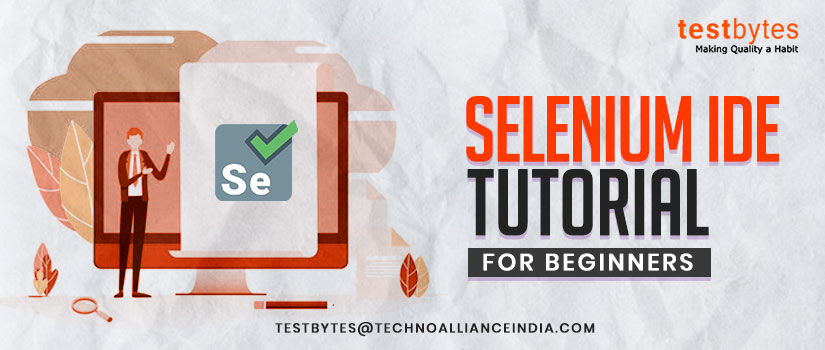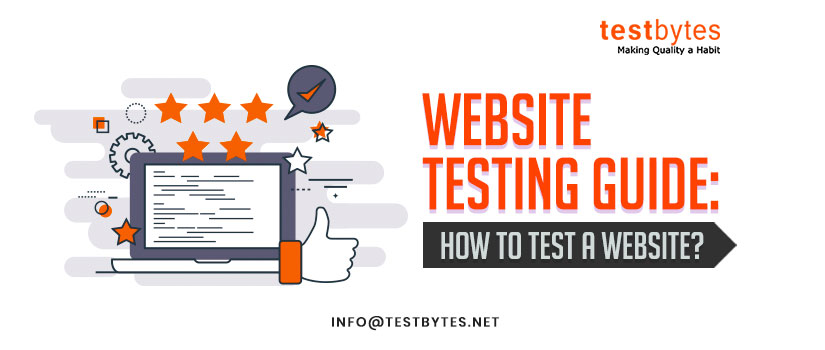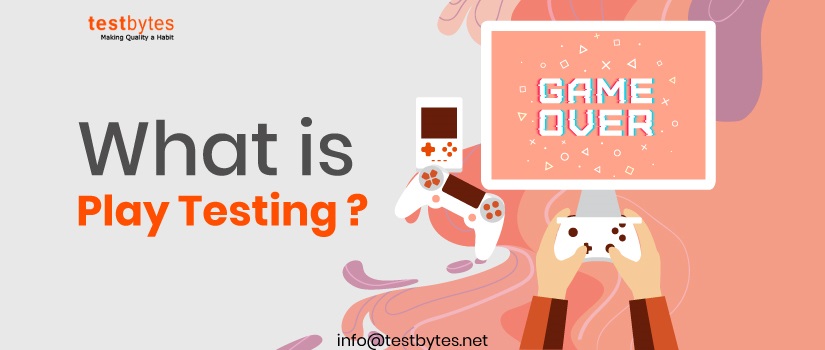
Requirements Elicitation in Software Engineering: A Complete Guide
February 28th, 2024
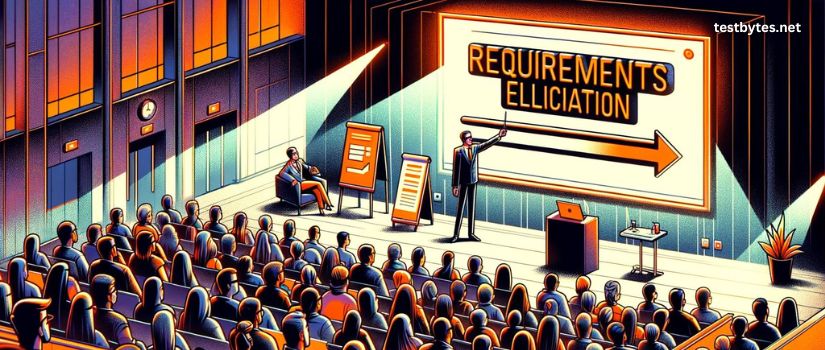
Technique #1. Brainstorming

Brainstorming, as a requirements elicitation technique, embodies a dynamic group activity focused on generating a wide array of ideas, solutions, and requirements for a project.
It thrives on leveraging the collective intelligence and creativity of the participants, usually comprising project stakeholders, team members, and potential users.
This technique is especially valuable in the initial phases of a project, where the goal is to explore various possibilities and identify innovative solutions without the constraints of criticism or feasibility considerations.
Key Objectives and Advantages:
- Idea Generation: Facilitates the rapid generation of a broad spectrum of ideas, allowing teams to explore various possibilities that might not emerge through individual contemplation.
- Enhanced Collaboration: Encourages active participation from all stakeholders, fosters a sense of ownership and collaboration across the project team, and ensures a diverse set of perspectives is considered.
- Creative Freedom: Creates a safe space for free thinking and sharing out-of-the-box ideas, which can lead to innovative solutions and uncover hidden requirements.
- Problem-Solving: Helps identify and solve complex problems by allowing team members to build on each other’s ideas, leading to more refined and comprehensive solutions.
Process and Implementation:
- Preparation: Define the scope and objectives of the brainstorming session, select a diverse group of participants, and choose a facilitator to guide the process.
- Idea Generation Phase: Participants are encouraged to freely express their ideas, no matter how unconventional they may seem, without fear of immediate critique or evaluation.
- Encouragement of Diverse Ideas: The facilitator encourages the exploration of different angles and perspectives, ensuring a wide-ranging discussion that can lead to innovative solutions.
- Building on Ideas: Participants build on each other’s suggestions, enhancing and expanding upon initial concepts, often leading to more refined and creative outcomes.
- Documentation: All ideas are recorded verbatim, ensuring nothing is lost or overlooked during the session. This record serves as a valuable resource for subsequent analysis and development phases.
- Analysis and Refinement: Following the session, ideas are categorized, evaluated, and refined. This stage may involve prioritization techniques to identify the most promising or critical ideas for further exploration or development.
Challenges and Considerations:
- Group Dynamics: Managing group dynamics to ensure equal participation and prevent dominance by more vocal participants is crucial for the success of a brainstorming session.
- Idea Saturation: There may be points during the session where ideas start to wane; the facilitator must employ strategies to reinvigorate the group and stimulate further creativity.
- Quality vs. Quantity: While brainstorming emphasizes the quantity of ideas over quality, it’s essential to eventually shift focus towards filtering and refining ideas to ensure they align with project goals and constraints.
Technique #2. Interviews

Interviews in requirements elicitation represent a fundamental, direct method for gathering detailed information from stakeholders.
This technique involves structured or semi-structured one-on-one or group discussions with individuals who have a stake in the project, such as end-users, business managers, project sponsors, and others who possess insights into the system’s requirements.
Through interviews, requirements analysts can delve deeply into the stakeholders’ needs, expectations, and experiences, facilitating a thorough understanding of the requirements for the new or improved system.
Key Objectives and Advantages:
- Depth of Insight: Interviews provide an opportunity to explore complex issues in detail, allowing for a deeper understanding of stakeholder needs and the nuances of their requirements.
- Clarification and Verification: They offer a direct channel for clarifying ambiguities and verifying assumptions, ensuring the elicited requirements are accurate and fully understood.
- Flexibility: The format of interviews can be adapted to suit the stakeholder’s familiarity with the subject matter and the specific goals of the elicitation process, ranging from open-ended discussions to more structured question-and-answer formats.
- Personal Engagement: Interviews facilitate personal interaction, building trust and rapport with stakeholders, which can encourage openness and sharing of critical insights that might not emerge through other elicitation techniques.
Process and Implementation:
- Planning: Identify the stakeholders to be interviewed and the objectives for each interview. Prepare a list of questions or topics to be covered, tailored to the interviewee’s role and level of expertise.
- Conducting Interviews: Depending on the chosen format (structured, semi-structured, or unstructured), the interviewer guides the conversation through prepared questions or topics while remaining open to exploring new insights that emerge.
- Active Listening: It’s crucial for the interviewer to practice active listening, paying close attention to the interviewee’s responses and asking follow-up questions to probe deeper into key areas.
- Documentation: Detailed notes or recordings (with the interviewee’s consent) should be taken to ensure that all information is captured accurately for later analysis.
- Analysis: The collected data is analyzed after the interview to identify and document the requirements. This may involve coding responses, identifying themes, and prioritizing the requirements based on the information gathered.
Challenges and Considerations:
- Bias and Influence: Interviewers must be aware of potential biases and strive to maintain neutrality, ensuring that the interviewee’s responses are not unduly influenced by how questions are phrased or presented.
- Time and Resource Intensive: Conducting and analyzing interviews can be time-consuming, particularly for projects with many stakeholders. Efficient planning and prioritization of interviews are essential.
- Interpretation and Accuracy: The subjective nature of personal communication requires careful interpretation of responses, particularly for open-ended questions, to ensure that the requirements are accurately understood and documented.
Technique #3. Surveys/Questionnaires

Surveys and questionnaires stand as highly scalable and efficient techniques for requirement elicitation, enabling data collection from a broad audience in a relatively short period of time.
This method is particularly useful when the project stakeholders are numerous or geographically dispersed, and there’s a need to gather a wide range of opinions, preferences, and requirements for the system under development.
This technique facilitates the quantitative and qualitative stakeholder needs analysis by deploying structured questions.
Key Objectives and Advantages:
- Broad Reach: Surveys and questionnaires can be distributed to many stakeholders simultaneously, making it possible to gather diverse perspectives efficiently.
- Quantitative and Qualitative Data: They can be designed to collect quantitative data (e.g., ratings, rankings) and qualitative insights (e.g., open-ended responses), providing a balanced view of stakeholder requirements.
- Anonymity and Honesty: Respondents might be more willing to provide honest feedback when anonymity is assured, leading to more accurate and truthful responses.
- Cost-Effective: Compared to other elicitation methods such as interviews and workshops, surveys and questionnaires are more cost-effective, especially when stakeholders are widespread.
Process and Implementation:
- Designing the Survey/Questionnaire: Carefully craft questions that align with the objectives of the requirements elicitation. The survey should include a mix of closed-ended questions for statistical analysis and open-ended questions to capture detailed comments and suggestions.
- Pilot Testing: Before widespread distribution, conduct a pilot test with a small, representative segment of the target audience to identify any ambiguities or issues in the questionnaire.
- Distribution: Choose the most effective means to distribute the survey, considering the stakeholders’ access to and familiarity with digital tools. In some settings, options include email, online survey platforms, or even paper-based questionnaires.
- Data Collection: Set a reasonable response deadline, and consider sending reminders to maximize the response rate.
- Analysis: Analyze the collected data to identify trends, patterns, and outliers. Quantitative data can be statistically analyzed, while qualitative responses require content analysis to extract meaningful insights.
- Feedback and Validation: Share the findings with key stakeholders for validation and to ensure that the interpreted requirements accurately reflect their needs and expectations.
Challenges and Considerations:
- Design Complexity: Crafting clear, unbiased questions capable of eliciting useful information requires careful consideration and expertise in survey design.
- Response Rate and Bias: Achieving a high response rate can be challenging, and the results may be biased toward the views of those who chose to respond.
- Interpretation of Responses: Analyzing open-ended responses and translating them into actionable requirements necessitates a deep understanding of the context and the ability to interpret stakeholder feedback accurately.
Question Types:
- Closed-Ended Questions: These questions limit responses to a set of predefined options. They are useful for gathering quantitative data that can be easily analyzed. Examples include multiple-choice questions, Likert scale questions for assessing attitudes or preferences, and yes/no questions.
- Open-Ended Questions: These allow respondents to answer in their own words, providing qualitative insights that can reveal nuanced understanding and novel ideas. While they are more valuable, they require more effort to analyze.
- Ranking and Rating Questions: These questions ask respondents to prioritize or rate different items according to their preferences or importance. They are useful for understanding the relative significance of various requirements.
Technique #4. Prototyping

Prototyping is a dynamic and interactive requirements elicitation technique that involves creating preliminary versions of a software system to explore ideas, uncover requirements, and gather feedback from users and stakeholders.
This approach allows for a tangible exploration of the system’s functionality and design before developing the full system.
Prototyping bridges the initial concept and the final product, facilitating a deeper understanding and communication among developers, users, and stakeholders. Here’s an in-depth look at how prototyping functions within the context of requirement elicitation:
Purpose and Benefits:
- Visualization and Concretization: Prototyping converts abstract requirements into tangible forms, enabling stakeholders to interact with a proposed system’s elements. This visualization helps clarify, refine, and validate requirements.
- Feedback Loop: It creates a continuous feedback loop, allowing users to provide immediate and actionable insights. This iterative process helps identify misunderstandings or missing requirements early in the development cycle.
- Experimentation and Exploration: Developers and stakeholders can experiment with different approaches and designs to explore the feasibility of certain features or requirements. It encourages innovation and creative solutions.
Types of Prototypes:
- Low-Fidelity Prototypes: These are quick and easy to create, often using paper sketches or simple digital mockups. They are useful for initial brainstorming and concept discussions.
- High-Fidelity Prototypes: More sophisticated and closer to the final product, these prototypes offer interactive features and a detailed user interface representation. They are used for more detailed feedback and usability testing.
- Functional Prototypes: These include working software elements, focusing on functional aspects rather than detailed design. They help in understanding the technical feasibility and functional behavior of the system.
Process and Implementation:
- Identify Prototyping Goals: Clearly define what aspects of the system the prototype will explore, such as specific functionalities, user interfaces, or workflows.
- Develop the Prototype: Create the prototype using appropriate tools and technologies based on the goals. The complexity of the prototype can vary depending on the requirements and the stage of the elicitation process.
- Gather Feedback: Present the prototype to users and stakeholders, encouraging them to interact with it and provide feedback on its functionality, design, and usability.
- Iterate and Refine: Use the feedback to revise and enhance the prototype. This iterative process may involve several rounds of prototyping and feedback to converge on the final set of requirements.
Challenges and Considerations:
- Managing Expectations: Ensure that stakeholders understand the purpose of the prototype and do not mistake it for the final product. Clear communication about the scope and objectives of prototyping is crucial.
- Resource Allocation: While prototyping can save time and resources in the long run by preventing rework, it does require an initial investment of time and resources. Balancing the depth and detail of prototyping against available resources is essential.
- Integration with Other Techniques: Prototyping is often most effective when used in conjunction with other requirement elicitation techniques, such as interviews, surveys, and workshops. This multi-faceted approach ensures a comprehensive understanding of requirements.
Technique #5. Document Analysis

Document Analysis is a systematic requirements elicitation technique that involves reviewing and interpreting existing documentation to identify and understand the requirements for a new system.
This method is particularly useful in projects with significant written material, such as reports, manuals, existing system specifications, business plans, and user documentation.
Document analysis helps capture explicit knowledge contained in these materials, offering insights into the system’s current state, business processes, and user needs, which can be invaluable for defining requirements for the new system.
Purpose and Benefits:
- Leverage Existing Knowledge: It uses documented information, reducing the need for extensive stakeholder consultations in the initial phase.
- Identify System Requirements: By analyzing existing documentation, analysts can uncover detailed information about the current system’s capabilities, limitations, and areas for improvement.
- Understand Business Processes: Documents related to business processes provide insights into how the organization operates, which is crucial for ensuring the new system aligns with business objectives.
- Gap Analysis: Reviewing documents can help identify discrepancies between the current state and the desired future state, guiding the development of requirements to bridge these gaps.
Process and Implementation:
- Identify Relevant Documents: The first step involves identifying and gathering all documents that could provide insights into the system and its requirements. This includes both technical documentation and business-related materials.
- Review and Analyze Documents: Conduct a thorough review of the collected documents, extracting relevant information related to the system’s functionality, business processes, user interactions, and any known issues or constraints.
- Synthesize Findings: Consolidate the information extracted from the documents to understand the existing system and the operational context. This synthesis helps in identifying key requirements for the new system.
- Validate and Refine Requirements: The preliminary requirements identified through document analysis should be validated with stakeholders and refined based on feedback. This ensures that the requirements accurately reflect the needs and constraints of the project.
Challenges and Considerations:
- Quality and Relevance of Documentation: The effectiveness of document analysis heavily depends on the quality and relevance of the available documentation. Outdated, incomplete, or inaccurate documents can lead to misunderstandings or misinterpreting requirements.
- Over-reliance on Existing Material: While existing documents are a valuable source of information, relying solely on document analysis can result in missed opportunities for innovation or improvement. Complementing this technique with other elicitation methods involving direct stakeholder engagement is essential.
- Integration with Other Techniques: To obtain a comprehensive and accurate set of requirements, document analysis should be used in conjunction with other elicitation techniques such as interviews, workshops, and prototyping. This blended approach ensures that both explicit knowledge contained in documents and tacit knowledge held by stakeholders are captured.
Technique #5 – Storyboarding
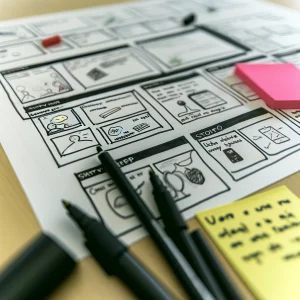
Storyboarding in the context of requirements elicitation is a visual and narrative-driven technique used to capture, communicate, and explore user requirements and experiences for a software system.
Originating from film and animation, storyboarding has been adapted into software development as an effective tool for illustrating the user’s journey, interactions with the system, and the context in which these interactions occur.
It involves creating a series of panels or frames that depict key scenarios or use cases, providing a storyboard that narrates the sequence of actions, decisions, and events a user goes through when interacting with the system.
Key Components of Storyboarding:
- Scenes: Each panel or frame represents a specific scene or step in the user’s interaction with the software, often starting from the initiation of a task and concluding with its completion or the achievement of a goal.
- Characters: Storyboards include representations of the user(s) or actor(s) involved in the scenario, providing a persona that interacts with the software.
- Actions: The actions or operations the user performs and system responses illustrate how tasks are executed and objectives are achieved.
- Annotations: Textual annotations accompany visual elements to provide context, describe user motivations, explain system functionality, or highlight requirements and constraints.
Benefits of Storyboarding:
- Enhanced Communication: Storyboards facilitate a shared understanding among stakeholders, developers, and designers by visually conveying complex scenarios and user interactions.
- User-Centered Design Focus: By centering the narrative around the user’s experience, storyboarding emphasizes the importance of designing solutions that meet real user needs and preferences.
- Early Validation: Allows for the early exploration and validation of design concepts and requirements with stakeholders, enabling feedback and revisions before significant development efforts are undertaken.
- Creativity and Innovation: Encourages creative thinking about possible solutions and innovations by visualizing user interactions and exploring different scenarios.
Process of Storyboarding in Requirements Elicitation:
- Identify Scenarios: Select key scenarios or use cases critical to understanding user interactions with the system. These scenarios should cover a range of normal, exceptional, and alternative flows.
- Define Characters: Create personas for the users involved in the scenarios to add depth to the narrative and ensure the system’s design addresses their specific needs.
- Sketch the Storyboard: Draw or use digital tools to create a sequence of panels that depict the user’s journey, including interactions with the system, decision points, and outcomes.
- Annotate and Describe: Add annotations to the storyboard to clarify actions, motivations, system responses, and any specific requirements or constraints the scenario highlights.
- Review and Iterate: Share the storyboard with stakeholders for feedback and use their input to refine the scenarios, requirements, and design concepts.
Challenges:
- Time and Skill: Creating effective storyboards can be time-consuming and requires a certain level of artistic skill or specialized tools.
- Complexity Management: Managing and integrating numerous storyboards can be challenging for complex systems with multiple user roles and interactions.
Technique #6: Ethnography
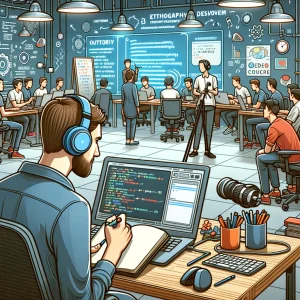
Ethnography, within the realm of requirements elicitation, refers to a qualitative research approach that deeply immerses researchers in the natural environment of their subjects to observe and understand their behaviors, practices, and interactions with technology.
This anthropological method is adapted to software development to gain insights into user needs, experiences, and the context in which a system will operate. It involves studying users in their work or life settings rather than in artificial environments or laboratory conditions.
Application for Requirements Elicitation:
- Direct Observation: Researchers observe users going about their daily tasks, noting how they interact with existing systems and identifying pain points, inefficiencies, and unmet needs that the new system could address.
- Participatory Observation: Sometimes, researchers actively participate in the environment they are studying to get a firsthand understanding of the user experience and the challenges users face.
- Interviews and Informal Conversations: Engaging with users in their natural settings allows researchers to gather nuanced insights through casual conversations, in-depth interviews, and group discussions.
- Artifact Collection: Gathering physical or digital artifacts that users interact with (e.g., documents, tools, software) provides additional context about their tasks and workflows.
Benefits:
- Deep Contextual Understanding: Ethnography offers an in-depth understanding of the user’s work environment, social interactions, and the cultural factors that influence their interactions with technology.
- User-Centered Design Insights: The rich, qualitative data collected can inform a more user-centered design process, ensuring that the system meets real user needs and fits seamlessly into their existing workflows.
- Identification of Tacit Needs: This approach can uncover implicit needs and requirements that users themselves might not be consciously aware of or able to articulate in a traditional elicitation setting.
Challenges:
- Time and Resource Intensity: Ethnographic studies can be time-consuming and resource-intensive, requiring extended periods of observation and analysis.
- Interpretation and Bias: The qualitative nature of the data collected requires careful interpretation, and researchers must be mindful of their own biases in observing and reporting on user behavior.
- Scalability: Given its intensive nature, ethnography may not be practical for all projects, especially those with tight timelines or limited resources.
Integration with Software Development:
Ethnography’s insights are particularly valuable in the early stages of software development, helping to define the problem space and identify user requirements.
The findings from ethnographic research can feed into the creation of personas, user stories, and use cases, guiding the design and development of the system.
When combined with other requirements elicitation techniques, such as interviews, surveys, and workshops, ethnography can provide a comprehensive understanding of user needs and the context within which the system will be used.
Technique #7: Use Case Approach

The Use Case Approach in requirements elicitation is a method that focuses on identifying and defining the interactions between a user (or “actor”) and a system to achieve specific goals.
This approach helps in capturing functional requirements by describing how the system should behave from the user’s perspective, providing a clear and concise way to communicate system behavior to both technical and non-technical stakeholders.
It plays a crucial role in the early phases of software development, ensuring that the software functionality aligns with user needs and expectations.
Key Components of the Use Case Approach:
- Actors: Represents the users or other systems interacting with the subject system. Actors are external entities that initiate an interaction with the system to accomplish a goal.
- Use Cases: Describes a sequence of actions the system performs that yields an observable value result to an actor. A use case is a specific situation or scenario under which the system interacts with its environment.
- Scenarios: Detailed narratives or sequences of events, including main, alternative, and exceptional flows, illustrating how actors interact with the system across different use cases.
Process and Implementation:
- Identify Actors: Identify all potential system users and other systems that might interact with it. This includes direct users, indirect users, and external systems.
- Define Use Cases: For each actor, define the specific interactions they have with the system. This includes the main objectives or tasks the actor wants to accomplish using the system.
- Write Scenarios: For each use case, write detailed scenarios that describe the steps the actor and the system take to achieve the goal. This includes the ideal path (main scenario) and variations (alternative and exception scenarios).
- Prioritize Use Cases: Prioritize the use cases based on factors such as business value, frequency of use, and complexity. This helps focus development efforts on the most critical aspects of the system.
- Validation and Refinement: Validate the use cases and scenarios with stakeholders to ensure they accurately represent user requirements. Refine the use cases based on feedback.
Benefits of the Use Case Approach:
- User-Centric: Focuses on user interactions, ensuring the system meets the actual needs and expectations of its users.
- Clear Communication: Provides a common language for discussing system requirements among stakeholders, including non-technical users.
- Identification of Functional Requirements: Helps in systematically identifying all the functional requirements of a system through the exploration of various user interactions.
- Facilitates Testing and Validation: Use cases can be directly used as a basis for developing test cases and validation criteria.
Challenges:
- Complexity in Large Systems: Managing and maintaining the use cases can become challenging for systems with many use cases.
- Overlooking Non-Functional Requirements: While excellent for capturing functional requirements, the use case approach may overlook non-functional requirements unless explicitly addressed.
The Use Case Approach in requirements elicitation is a powerful tool for understanding and documenting how a system should interact with its users. Focusing on the user’s goals and describing system interactions from the user’s perspective ensures that the developed system can perform its intended functions effectively and meet user expectations.

Requirements Engineering (RE) is a comprehensive discipline within software engineering that encompasses all activities related to the identification, documentation, analysis, and management of the needs and constraints of stakeholders for a software system. Requirements elicitation is a critical phase within this broader discipline, focusing specifically on the initial gathering of these needs and constraints from stakeholders. The relationship between Requirements Engineering and Requirements Elicitation can be understood through their roles, objectives, and how they contribute to the development process.
Role in Software Development:
- Requirements Engineering: Serves as the foundational process in software development that ensures the final product is aligned with user needs, business objectives, and operational constraints. It covers the entire lifecycle of requirements management, from discovery through maintenance and evolution post-deployment.
- Requirements Elicitation: This acts as the initial step in the RE process, where the goal is to discover the needs, desires, and constraints of the stakeholders through various techniques such as interviews, surveys, and observation.
Objectives:
- Requirements Engineering: Aims to establish a clear, consistent, and comprehensive set of requirements that guide the design, development, and testing phases of software development. It seeks to manage changes to these requirements effectively throughout the project lifecycle, ensuring the software remains aligned with stakeholder expectations and business goals.
- Requirements Elicitation: Focuses on accurately capturing stakeholders’ explicit and tacit knowledge to understand what they expect from the new system, why they need it, and how it will fit into their current operational context.
Contributions to Software Development:
- Requirements Engineering:
- Ensures a systematic approach to handling requirements, reducing the risk of project failures due to misaligned or misunderstood stakeholder needs.
- Facilitates clear communication between stakeholders and the development team as a continuous reference point for validating the software’s alignment with intended outcomes.
- Helps prioritize requirements based on business value, technical feasibility, and stakeholder impact, guiding resource allocation and project planning.
- Requirements Elicitation:
- Provides the initial set of data that forms the basis for all subsequent requirements engineering activities, including analysis, specification, validation, and management.
- Helps in identifying potential challenges, constraints, and opportunities early in the development process, allowing for proactive planning and design adjustments.
- Engages stakeholders from the outset, fostering a sense of ownership and collaboration that can enhance project outcomes and stakeholder satisfaction.
Integration within the Development Process:
The seamless integration of requirements elicitation into the broader requirements engineering process is crucial for the success of software projects. Elicitation feeds vital information into the RE process, which then undergoes analysis, specification, and validation to produce a well-defined set of system requirements. This iterative process of refinement and feedback ensures that the evolving understanding of stakeholder needs is accurately reflected in the project’s goals and deliverables.
“Many Business Analysts Use a Combination of Requirements Elicitation Techniques”
When you begin delving into every strategy, you understand that it is tough to do as an independent action.
For instance, brainstorming regularly occurs as a significant aspect of a requirements workshop that can also have an interview segment.
Or on the other hand, to plan an interview, you must first do some record analysis to think of a list of inquiries.
Or on the other hand, to motivate your interviewees to provide you with great data, they need to see a model.
The Requirements Elicitation methods can be joined in whatever way to accomplish the outcome you ask for from their venture. Also, we won’t get to choose elicitation methods from outside of business analysis, which is another approach to increasing your business analysis abilities.
How to Prepare for Requirements Elicitation?
• The first step is to take time and do some research, have multiple discussions,s and find out the business need of the project
• Understanding of the business need will make sure that scope creep and gold plating won’t happen
• Make sure that you have chosen the right technique for requirement elicitation
• The analyst must ensure that an adequate number of stakeholders are added to the project
• Make sure that the stakeholders are actively engaging from the requirement phase itself
• Stakeholders include SMEs, customer end users, project managers, project sponsors, operational support regulators, etc.
• All of them can’t be included in each project. Include stakeholders based on requirements
Final words…
In the business context, it is needed to have a viable method for market surveying to comprehend what a consumer needs and how to be productive over contenders.

We must concentrate on the most proficient technique to influence the users to accomplish their objectives.
The Requirements Elicitation collection procedure will help understand a consumer’s necessities, particularly in the IT business.
Your company’s structure, political atmosphere, the essence of your venture, and your qualities and choices will have much to do with which techniques work best for you.


 Software Testing Events
Software Testing Events App Testing
App Testing Web App Testing
Web App Testing Game Testing
Game Testing Automation Testing
Automation Testing Load Testing
Load Testing Security Testing
Security Testing Performance Testing
Performance Testing Hire a Tester
Hire a Tester



